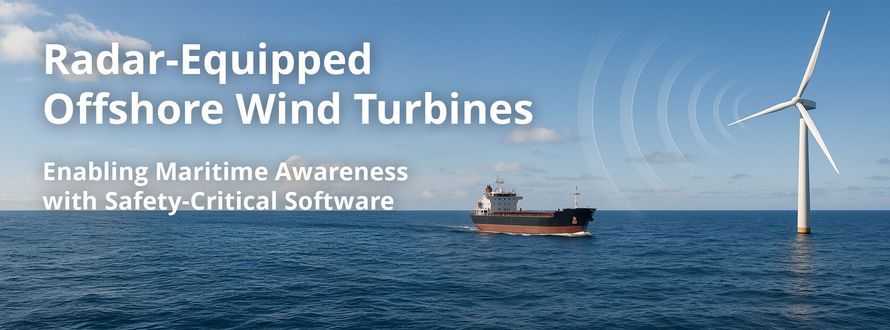Offshore wind farms are rapidly expanding as a cornerstone of the global renewable energy strategy. These massive infrastructures not only produce clean energy but are increasingly being viewed as valuable assets for maritime situational awareness. With the integration of advanced radar sensors, offshore wind turbines are becoming intelligent observation points that can track vessel movements and activities across vast sea regions. This trend reflects a broader transformation of offshore energy platforms—from isolated generators to nodes in a sophisticated, sensor-driven maritime network.
Let's explore the technical and security challenges involved in turning offshore wind turbines into intelligent radar platforms and how SYSGO's safety- and security-certified real-time operating system (RTOS), PikeOS, can provide a robust foundation for building these critical applications.
Introduction: The Offshore Wind Farm as a Maritime Sensor Network
The offshore wind energy sector is undergoing a quiet evolution. Beyond the generation of clean energy, these turbines are being outfitted with radar systems, Automatic Identification System (AIS) receivers, cameras, and other maritime surveillance tools. The goal is twofold:
Enhance Safety and Security: Monitoring vessel activity can prevent accidents, detect unauthorized approaches, and support maritime law enforcement and search-and-rescue operations.
Enable Maritime Domain Awareness (MDA): By networking the sensors from dozens or even hundreds of turbines, a comprehensive picture of maritime activity can be constructed in real time, covering vast sea areas with unprecedented resolution.
This approach transforms the role of offshore wind farms, embedding them into the digital backbone of coastal surveillance systems. Governments and private operators alike are exploring how to leverage these platforms for civil, environmental, and defense applications.
Technical Challenges
While the vision is promising, several significant technical challenges must be addressed to turn offshore turbines into reliable maritime radar nodes:
1. Harsh Environmental Conditions
Offshore platforms must operate in extreme weather conditions—high winds, salty air, moisture, and fluctuating temperatures. The embedded systems must be highly reliable, ruggedized, and capable of autonomous operation for extended periods without physical maintenance.
2. Real-Time Data Processing
Radar data is complex and high-volume. Real-time tracking of moving vessels requires rapid signal processing and low-latency communication. Processing must be deterministic and respond to time-critical events without delay.
3. Cybersecurity Threats
Connecting turbines into a large network introduces cybersecurity vulnerabilities. The system must be protected against attacks ranging from unauthorized access and data tampering to more sophisticated threats such as jamming and spoofing of radar signals.
4. Safety and Mixed-Criticality
Radar operation, safety monitoring, turbine control, and communication must all coexist on the same platform. These functions differ in their safety criticality. For instance, turbine pitch control must meet real-time safety standards, while radar processing may be mission-critical but not safety-critical. This requires separation and prioritization mechanisms.
5. Connectivity and Scalability
Creating a sensor network across tens or hundreds of turbines requires secure, high-bandwidth communication and distributed system coordination. The software infrastructure must support scalability and fault tolerance in a decentralized environment.
SYSGO’s Solutions: PikeOS and Safe Virtualization
SYSGO’s PikeOS RTOS and hypervisor offers a powerful platform to address these challenges.
1. Safe and Secure Partitioning
PikeOS supports mixed-criticality systems by allowing multiple applications with different safety and security levels to run on a single hardware platform. This is achieved through time and space partitioning, ensuring that a fault or breach in one partition does not affect others. For offshore radar systems, this enables the integration of real-time radar processing, turbine control, and secure communication within isolated partitions.
2. Certification-Ready Architecture
PikeOS is certified to DO-178C, ISO 26262, and IEC 61508 standards, which are crucial for safety-critical systems in industrial and aerospace domains. The OS offers pre-certification packages and artifacts that significantly reduce the effort required to achieve compliance. This is essential for radar systems that may need to comply with civilian or defense-grade safety regulations.
3. Real-Time Performance
With its hard real-time capabilities, PikeOS ensures that radar data is processed deterministically. This allows accurate tracking of fast-moving vessels in real-time, critical for maritime surveillance and early warning applications.
4. Cybersecurity by Design
PikeOS has been certified to the Common Criteria EAL 5+ standard and includes built-in features to support secure boot, encryption, access control, and network isolation. This is vital for offshore platforms exposed to potential cyber intrusions via remote connections. Security can also be enhanced through Trusted Execution Environments (TEE) implemented in PikeOS partitions.
5. Edge Computing and Remote Management
To minimize latency and reduce dependency on remote data centers, PikeOS can be deployed as part of an edge computing node directly on the turbine. SYSGO also provides tools for remote monitoring, diagnostics, and updates—enabling centralized management of large offshore radar sensor networks.
Future Outlook: Toward a Smart Maritime Grid
As offshore wind energy expands and nations place more focus on maritime security, the integration of radar systems into wind turbines will become increasingly standard. We foresee the development of a smart maritime grid where:
- Turbines act as both energy generators and data nodes.
- AI-driven analytics run on edge devices to detect anomalies in vessel movement.
- Maritime drones and autonomous surface vehicles collaborate with turbine radar data for patrol and inspection missions.
- Integration with national defense systems becomes seamless through standardized APIs and architectures like MOSA and FACE.
PikeOS’s modular, standards-compliant foundation positions it as a key enabler for this evolution. It provides not only the technical underpinnings for safe and secure sensor integration, but also the long-term maintainability and certification support needed in such complex, regulated environments.
Conclusion
Offshore wind turbines equipped with radar sensors represent a powerful synergy between renewable energy and maritime situational awareness. The transformation of these platforms into intelligent observation points comes with considerable technical challenges, especially in the domains of safety, real-time performance, and cybersecurity. SYSGO’s PikeOS RTOS offers a robust and future-proof solution for developing and deploying such applications safely and reliably.
As the need for maritime security, surveillance, and environmental monitoring grows, radar-equipped offshore turbines will play a vital role—not just as sources of energy, but as sentinels of the sea.

